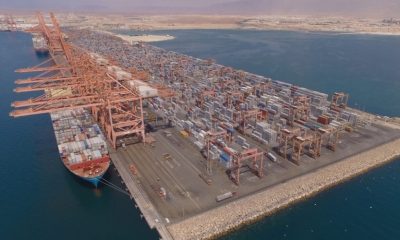Banking & Finance
Oman’s Banking & Finance Sector Outlook

Oman’s banking sector remained strong while supporting the growth of diversified economic activities in the Sultanate in 2018. The credit extended by ODCs (conventional and Islamic banks) increased by 6.4 per cent during 2018, on the top of a similar growth in 2017, in line with growth in the economy.
Read: Enriching Private Banking Experience
Notably, the healthy growth in bank credit was attained despite intermittent liquidity tightening and hardening of interest rates. Strategically significant economic sectors were the main recipients of the credit disbursed in 2018, as credit to the manufacturing, transport & communications and services sectors increased by 19.6 per cent, 13 per cent and 17.5 per cent, respectively, during the year.
Read: HE Tahir bin Salim Al Amri, Executive President, Central Bank of Oman on Oman’s banking sector
Furthermore, the growth in credit was supported by aggregate deposits, which grew by 7.8 per cent in 2018 as compared to 5.6 per cent in 2017.

The domestic interest rates remained on the upward trajectory in 2018, following the trends in the USA. The weighted average interest rate on rial Omani deposits hardened to 1.899 per cent in December 2018 from 1.667 per cent in December 2017, while that on rial Omani lending increased to 5.329 per cent from 5.204 per cent during this period.
Despite healthy growth in credit, the banking sector displayed resilience and remained adequately capitalised with Basel capital adequacy ratio at 16.5 in September 2018, much higher than the mandated at 12.875 per cent.
Read: Sheikh Waleed K. Al Hashar, CEO, Bank Muscat shares the bank’s initiatives
At the same time, the economic recovery helped banks to maintain the quality of loans and delinquency rate remained low, albeit gross non-performing loans of conventional banks (including Islamic windows) witnessed some uptick to 2.7 per cent in September 2018 from 2.0 per cent in December 2017.
Overall, the banking sector performed well in 2018, providing adequate credit and other banking services efficiently to all segments of the economy while pursuing prudent practices to mitigate risks.
Regulatory policies
The Central Bank of Oman (CBO) continued to pursue policies so that the banking sector fulfills its role of financial intermediation efficiently in the economy without posing any threat to financial stability.
Towards this objective, the CBO undertook several policy measures in 2018, enabling additional space for lending and effective liquidity management of banks, among others. The minimum capital adequacy ratio (CAR) as a percentage of risk weighted assets was reduced from 12 per cent to 11 per cent effective from April 1, 2018.
Read: Excerpts from an interview with CEO, Abdul Hakeem Al Ojaili
The CBO allowed banks to reckon their net domestic inter-bank borrowings as part of the deposit base for lending ratio purpose in order to expand the room for additional lending. The CBO also withdrew the minimum 100 per cent risk weight requirement on exposures to other Sovereigns and Central Banks, and followed the Basel norms in this regard.

Furthermore, the prudential limit for credit exposures to non-residents and placement of funds abroad as percentage of local net worth was raised to 75 per cent from 50 per cent earlier to provide greater operational flexibility for efficient treasury operations, liquidity management, sound correspondent relationships, etc.
The prudential limits have been increased for all currencies’ liquidity gap based on different maturity time bands. As part of its commitment to the Basel Committee on Banking Supervision Reforms (Basel III), the CBO continued with the phased implementation of Liquidity Coverage Ratio (LCR) and Net Stable Funding Ratio (NSFR).
The banks were asked to maintain a minimum LCR at 90 per cent in 2018 and 100 per cent by January 2019 to ensure adequate high-quality liquid assets with them. The NSFR, which provides a better assessment of funding risk across all on- and off-balance sheet items, has been implemented in 2018 as a minimum standard of 100 per cent as per Basel Committee’s timeline.
All these measures are expected to help the banking sector in meeting the increased credit requirements and attaining higher operational efficiency without increasing any systemic risk.
Since the onset of Islamic banking in the Sultanate in 2013, Islamic Banking entities (IBEs) have made remarkable progress and contributed efficiently to financial intermediation in Oman. The introduction of Islamic Banking has not only filled the gap but also contributed to improvement in overall efficiency in banking services through infusing competition and providing alternative financial instruments to the niche clients. Currently, IBEs operating in Oman include two full-fledged Islamic banks and six Islamic banking windows (created by six local banks) with 76 branches across the country.
Read: Interview with Said Abdullah al Hatmi, CEO of Ahlibank
Financing extended by Islamic banks and windows witnessed a remarkable average annual growth of 58.1 per cent during the period 2014-2018 and stood at RO3.6 billion at the end of December 2018. Total assets of Islamic banks and windows, which grew remarkably by an annual average of 37.4 per cent during 2014-2018, stood at RO4.4billion and constituted 13 per cent of total banking sector assets in December 2018.
CBO has also been encouraging the growth of Islamic Banking in the Sultanate through various policy interventions. IBEs are exempted from limits of exposure to personal and housing finance, allowing them to establish a retail sector-financing portfolio.
Furthermore, prudential limits pertaining to overseas investments were not made applicable to IBEs as there were no feasible Sharīʻah-compliant investment opportunities in the Sultanate. Although the performance of IBEs has been remarkable so far, the regulators are cognisant of the fact that more is needed for their sustainable growth and efficient operations.

In this regard, the strategic plans include liquidity management frameworks and instruments, diversified financing portfolios and innovative Islamic finance products. With the introduction of novice products, especially for corporate customers and SMEs, and Sharīʻah-compliant liquidity management tools for interbank and central bank interface, the Islamic banking is expected to maintain a considerable growth and achieve its full potential.
Future outlook
The outlook for Oman’s banking sector is favourable and healthy profit growth has only been slightly tempered by the introduction of new accounting standards.
The implementation of IFRS 9 in 2018 transformed the banks’ approach to assessing impairments in their loan portfolios. Coupled with higher current provisions, such as liquidity coverage ratio and net stable funding ratio calculations becoming more stringent, the cost of liquidity seemed to increase. Yet both net profit and total assets of the top eight Omani banks have grown by 11.5 per cent and 7.3 per cent, respectively.
Increased digitalisation and customers’ expectations for ‘superior experience’ have led many banks to adopt customer identity and access management (CIAM) in order to build stronger relationships with their clients. CIAM’s features help to address numerous customer needs, including delivering personalised experiences, intelligent solutions, protection against cyber fraud and ease of digital interaction.
Banks’ risk functions are also operating against a backdrop of regulatory evolution. The London Interbank Offered Rate (Libor) is being phased out, to be replaced by alternatives such as risk-free rate (RFR) benchmarks. Banks would be advised to reduce LIBOR exposures and build demand for RFR-linked products.
Operational risk also looks to be in the spotlight, given issues around anti-money laundering (AML) fines, third-party concern and cyber threat. Compliance is paramount with respect to fraud risk regulations laid out by the CBO, which enlist governance, identification and assessment, control and mitigation, business continuity management, information technology and systems, and reporting as focus areas.
Financial crime risk maybe reduced by exploiting machine learning to maximise operational efficiency and risk mitigation measures to comply with regulatory provisions on AML and sanctions as Oman prepares for its Financial Action Task Force (FATF) Mutual Evaluation, scheduled for 2021.
Islamic finance is proving to be a key growth driver, as the GCC consolidates its position as a globally significant economic hub. Continued growth may be encouraged with greater transparency, the addition of more Islamic banking experts, and strengthening of the public’s confidence in Sharia-compliant products and services.
Read: Andrew Long, CEO, HSBC Bank Oman says the bank has outperformed its peers on various metrics
Finally, sustainability reporting appears to be emerging as an essential consideration. Sustainability disclosures may help banks access new markets and implement more well-rounded risk management processes. Increasingly, stakeholders seem to expect banks to not only exceed their financial targets, but to also formulate a canny, forward-looking strategy for the long term.
Holding companies
Amongst holding companies OMINVEST has seen a remarkable growth over the last 5 years. OMINVEST’s net profit has more than doubled from RO14.5 million in 2014 to RO30.5 million in 2018 and its revenue mix has become much more diversified. For instance, banking sector investments accounted for 82 per cent of revenues in 2014.
At the end of 2018, banking sector contribution stood at just 44 per cent due to higher contribution from other businesses, such as insurance and leasing. In 2015, the big leap OMINVEST went through a landmark merger with ONIC Holding.
The merger transformed OMINVEST into a much bigger and a more diverse company. Subsequently, it took several initiatives to grow it’s portfolio organically by building large equity stakes in blue chip companies during the downturn and increasing allocation to it’s subsidiaries for growth opportunities in the insurance, private equity and real estate sectors.
Over the last five years, OMINVEST has grown its profitability and added value for shareholders, amid low oil prices, a weak macro environment and tough business conditions.
For the year 2018, OMINVEST reported a strong set of results. Total group revenues rose by 17 per cent to RO277.5 million and the net profit grew by 47 per cent to RO30.5 million from RO20.8 million in 2017. In view of the company’s strong growth and robust profitability, it distributed a 25 per cent dividend split as 20 per cent cash and five per cent as stock dividend.
This was the highest cash per share distribution to shareholders since inception, adjusted for stock dividends. The strong overall performance in 2018 was attributable to the results of OMINVEST’s major subsidiaries including Oman Arab Bank (OAB), National Life & General Insurance (NLGIC), Oman Real Estate Investment and Services (ORIS), Jabreen Capital it’s key associates like National Finance Company.
NBFCs Facing strong headwinds
Oman’s non-banking finance companies (NBFCs) sector faced major challenges during the year 2018, such as liquidity crunch, increasing defaults, delayed payments and increased provisioning requirements. In addition, there has been stiff competition from commercial banks and Islamic banks including the Islamic windows of commercial banks in the retail and SME segment. To meet the regulatory requirements, the banks were also aggressive in the SME segment and they have managed to wean away customers in this segment from NBFCs bringing down both the credit quality and yields.
As observed by Aftab Patel, CEO of Al Omaniya Financial Services, in his management discussion and analysis report submitted at Muscat Securities Market (MSM), the NBFCs witnessed a problematic year as the tightening of liquidity in the market has raised the cost of funding and also raised the fears about steep hike in interest rates amidst prevailing depressed business sentiments.
Patel says, “Against the backdrop of the challenging economic situation, the financial institutions were facing the herculean task of maintaining adequate liquidity and a healthy asset quality. The withdrawal of the government deposits placed in the local market has created a stress in the liquidity resulting in the steady increase in the interest cost of NBFCs. Oman’s non-banking finance companies are undergoing challenging times as the slowdown in their assets growth, declining margins and increasing non-performing loans has put further pressure on their profitability. Going forward, the low credit offtake combined with the increasing funding cost, reduced margins, and increasing NPLs may put pressure on the profitability of the NBFCs and they may find it increasingly challenging to maintain the level of profitability unless the economic situation improves.”
Robert Pancras, CEO of National Finance says in his company’s management discussion and analysis report submitted at MSM, “The leasing and finance sector showed slack growth during 2018 on account of marked increase in cost of funds and a general slowdown in both the government and private sectors. We have witnessed a slowdown in credit offtake due to dearth of new projects combined with a retarded growth of contracting companies in major segments viz. oil and gas, infrastructure, construction etc due to delays in the payments to government project contractors.”
In 2018, National Finance Company emerged as the largest non-banking finance company in the country, after successfully completing the acquisition of Oman Orix Leasing Company through a merger. Says Taya Jandal Ali, Chairman of the company, “The company continues to follow a prudent provisioning policy based on its assessment of the risks inherent to its portfolio and is in full compliance with provisioning norms prescribed by the Central Bank of Oman and the International Financial Reporting Standards.”
Says Mohamed Abdulla Al Khonji, Chairman of United Finance Company (UFC), “2018 was a tough year for FLC’s as a whole. The market witnessed a slowdown in implementation of developmental projects thus providing limited opportunities for expansion of business. This triggered a decline in the demand for commercial vehicles and equipment due to a dearth of avenues for deployment of assets, excess capacity, drop in hiring rates and delayed settlement of dues by contractors. The sale of private vehicles also registered a decline as a result of increase in cost of living and the conservative outlook of citizens and residents. These developments resulted in a decline in the overall market size triggering intense competition. Banks continued their penetration into vehicle financing and SME funding segment further reduced the market share of FLCs and increased competition among peers. Though there were indications of easing of market liquidity, it was volatile and pushed up borrowing cost. This resulted in finer margins and decline in net interest income. The market continued to reel under the delayed payment cycle resulting in the strained cash flow of borrowers. This resulted in a cascading effect of borrowers delaying / defaulting on their loan obligations and triggered the increase in the incidence of delinquencies during the year.”
Another major player, Muscat Finance has increased the business booking during the year to very close to its own set targets, with a slightly modified business composition. Says Faisal bin Mohamed Al Yousef, Chairman of the company, “Muscat Finance is anticipating that the more conservative risk approach will lower the levels of delinquency going forward and counter the effect of the few older accounts that experienced significant stress lately, largely due to the tight payments and liquidity situation of contractors. We expect this to set the stage for a sustained and improved future profitability.”
Considering that the operating conditions are still challenging for the finance and leasing sector, NBFCs are expected to gear up their credit analysis, monitoring and risk management practices to keep the credit risk within manageable limits rather than focusing on book building.
Optimistic trends
Despite the recent recovery in oil prices, the Government of Oman has maintained its aim to continue with its prudent fiscal management including controlling current spending. Analysts are cautiously optimistic about economic situation of Oman in light of a focused development plan, the prioritisation of public investment, focused growth of SMEs and concerted effort on the diversification plan.
With low oil prices, payments to large infrastructure projects are expected to remain delayed, continuing the cash flow strain in the economy. This is expected to have an impact on the quality of assets with banks and FLCs, going forward. Increased cost of borrowings owing to tight liquidity conditions in the market may impact net interest income and profits. If the cash flow situation remains difficult in the first half of the year, then there will be an increase in non-performing loans with subsequent impact on provisioning and profits.
Faisal Al Hashar, Chairman of Taageer Finance, says, “The liquidity position in the market is expected to continue to be tight. The banks continue to adopt a cautious approach in lending and continued to increase interest rates, hence sustaining a high growth rate in terms of new business does pose a major challenge to the FLC Industry.”
Adds Khalid Said Al Wahaibi, Chairman of Al Omaniya Financial Services, “We continue to foresee an extremely challenging year ahead. The company is resilient and cautiously optimistic of posting satisfactory performance in 2019. The company is well aware of the current economic scenario and has initiated proactive mitigating measures. The company is fundamentally strong with solid net worth, clean loan book, lowest Non Performing Loans and high Non performing asset coverage. As such the company has the ability to operate competitively and post satisfactory performance in the coming years.”
Diminishing margins due to intense competition from banks, liquidity crunch in the market, increasing trend in the cost of funds, expected reduction in both private and public spending, delayed payments on the existing contracts and expected delinquencies due to reduced cash flow at the individual and corporate borrower’s level and liquidation of major contracting companies are causes of concern.
The impact of the low credit off take and the slow economic momentum could impact the business volumes and top line growth on the one hand and the increase in delinquencies may impact the net margins and result in dilution of the NPA coverage.
 This article was first published in Progress (Al Takkadum) 2019-2020. To read the e-version of the magazine, click here.
This article was first published in Progress (Al Takkadum) 2019-2020. To read the e-version of the magazine, click here.
-

 Alamaliktistaad Magazines1 month ago
Alamaliktistaad Magazines1 month agoAl-iktisaad, November 24
-

 Oman2 months ago
Oman2 months agoShell Oman Partners with Oneroad Automotive Gives Away 2 Forthing Cars as Part of its ‘Win Big’ Campaign
-

 Energy1 month ago
Energy1 month agoOman and Belgium Strengthen Green Hydrogen Partnership with New Landmark Agreement
-

 Energy1 month ago
Energy1 month agoOUTLOOK: Emerging Markets and Renewables – The Twin Engines of Energy Growth for 2025
-

 Oman1 month ago
Oman1 month agoOman Braces for Launch of First Experimental Rocket Duqm-1 on 4 December 2024
-

 News1 month ago
News1 month agoMitsubishi X-force Joins Sayarti’s Fleet: A New Era of Elegance and Performance
-

 Oman1 month ago
Oman1 month agoTransport Ministry Issues New Regulation for Security of Ships, Ports
-

 Technology4 weeks ago
Technology4 weeks agoEXCLUSIVE: Technological Singularity – Will It Become Humanity’s Greatest Leap or Its Most Perilous Step?































You must be logged in to post a comment Login